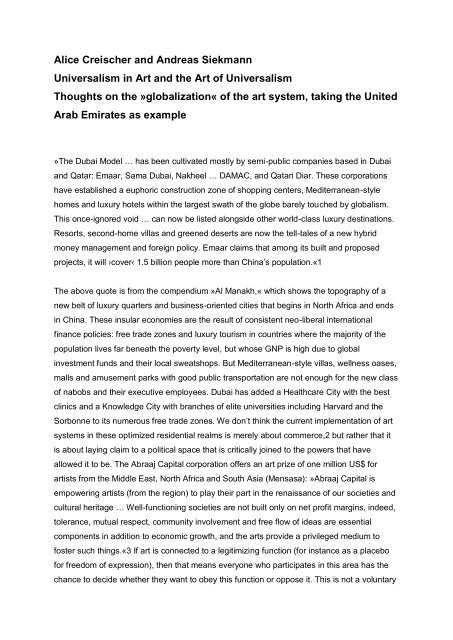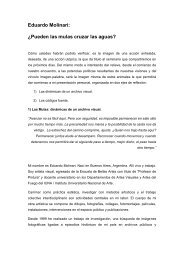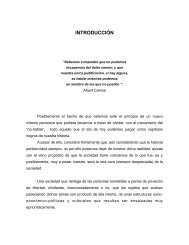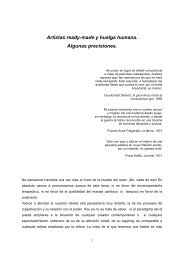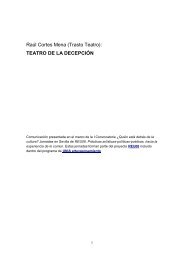Alice Creischer and Andreas Siekmann Universalism in Art and the ...
Alice Creischer and Andreas Siekmann Universalism in Art and the ...
Alice Creischer and Andreas Siekmann Universalism in Art and the ...
Create successful ePaper yourself
Turn your PDF publications into a flip-book with our unique Google optimized e-Paper software.
<strong>Alice</strong> <strong>Creischer</strong> <strong>and</strong> <strong>Andreas</strong> <strong>Siekmann</strong><br />
<strong>Universalism</strong> <strong>in</strong> <strong>Art</strong> <strong>and</strong> <strong>the</strong> <strong>Art</strong> of <strong>Universalism</strong><br />
Thoughts on <strong>the</strong> »globalization« of <strong>the</strong> art system, tak<strong>in</strong>g <strong>the</strong> United<br />
Arab Emirates as example<br />
»The Dubai Model … has been cultivated mostly by semi-public companies based <strong>in</strong> Dubai<br />
<strong>and</strong> Qatar: Emaar, Sama Dubai, Nakheel … DAMAC, <strong>and</strong> Qatari Diar. These corporations<br />
have established a euphoric construction zone of shopp<strong>in</strong>g centers, Mediterranean-style<br />
homes <strong>and</strong> luxury hotels with<strong>in</strong> <strong>the</strong> largest swath of <strong>the</strong> globe barely touched by globalism.<br />
This once-ignored void … can now be listed alongside o<strong>the</strong>r world-class luxury dest<strong>in</strong>ations.<br />
Resorts, second-home villas <strong>and</strong> greened deserts are now <strong>the</strong> tell-tales of a new hybrid<br />
money management <strong>and</strong> foreign policy. Emaar claims that among its built <strong>and</strong> proposed<br />
projects, it will ›cover‹ 1.5 billion people more than Ch<strong>in</strong>a’s population.«1<br />
The above quote is from <strong>the</strong> compendium »Al Manakh,« which shows <strong>the</strong> topography of a<br />
new belt of luxury quarters <strong>and</strong> bus<strong>in</strong>ess-oriented cities that beg<strong>in</strong>s <strong>in</strong> North Africa <strong>and</strong> ends<br />
<strong>in</strong> Ch<strong>in</strong>a. These <strong>in</strong>sular economies are <strong>the</strong> result of consistent neo-liberal <strong>in</strong>ternational<br />
f<strong>in</strong>ance policies: free trade zones <strong>and</strong> luxury tourism <strong>in</strong> countries where <strong>the</strong> majority of <strong>the</strong><br />
population lives far beneath <strong>the</strong> poverty level, but whose GNP is high due to global<br />
<strong>in</strong>vestment funds <strong>and</strong> <strong>the</strong>ir local sweatshops. But Mediterranean-style villas, wellness oases,<br />
malls <strong>and</strong> amusement parks with good public transportation are not enough for <strong>the</strong> new class<br />
of nabobs <strong>and</strong> <strong>the</strong>ir executive employees. Dubai has added a Healthcare City with <strong>the</strong> best<br />
cl<strong>in</strong>ics <strong>and</strong> a Knowledge City with branches of elite universities <strong>in</strong>clud<strong>in</strong>g Harvard <strong>and</strong> <strong>the</strong><br />
Sorbonne to its numerous free trade zones. We don’t th<strong>in</strong>k <strong>the</strong> current implementation of art<br />
systems <strong>in</strong> <strong>the</strong>se optimized residential realms is merely about commerce,2 but ra<strong>the</strong>r that it<br />
is about lay<strong>in</strong>g claim to a political space that is critically jo<strong>in</strong>ed to <strong>the</strong> powers that have<br />
allowed it to be. The Abraaj Capital corporation offers an art prize of one million US$ for<br />
artists from <strong>the</strong> Middle East, North Africa <strong>and</strong> South Asia (Mensasa): »Abraaj Capital is<br />
empower<strong>in</strong>g artists (from <strong>the</strong> region) to play <strong>the</strong>ir part <strong>in</strong> <strong>the</strong> renaissance of our societies <strong>and</strong><br />
cultural heritage … Well-function<strong>in</strong>g societies are not built only on net profit marg<strong>in</strong>s, <strong>in</strong>deed,<br />
tolerance, mutual respect, community <strong>in</strong>volvement <strong>and</strong> free flow of ideas are essential<br />
components <strong>in</strong> addition to economic growth, <strong>and</strong> <strong>the</strong> arts provide a privileged medium to<br />
foster such th<strong>in</strong>gs.«3 If art is connected to a legitimiz<strong>in</strong>g function (for <strong>in</strong>stance as a placebo<br />
for freedom of expression), <strong>the</strong>n that means everyone who participates <strong>in</strong> this area has <strong>the</strong><br />
chance to decide whe<strong>the</strong>r <strong>the</strong>y want to obey this function or oppose it. This is not a voluntary
appeal for a boycott or <strong>in</strong>tervention (as if that were so simple), but first an appeal to focus<br />
one’s attention on <strong>the</strong> fact that a political space is be<strong>in</strong>g opened that <strong>in</strong>vites all those<br />
concerned, <strong>and</strong> that <strong>in</strong>cludes us, to react. It can also be <strong>the</strong> beg<strong>in</strong>n<strong>in</strong>g of a discussion about<br />
a political self-image with<strong>in</strong> <strong>the</strong> current <strong>in</strong>ternationalization of art systems that cannot be<br />
satisfied with <strong>in</strong>clud<strong>in</strong>g all <strong>the</strong> regions <strong>in</strong> <strong>the</strong> hegemonic world of art. This transfer from <strong>the</strong><br />
fr<strong>in</strong>ges to <strong>the</strong> centers is not emancipatory per se. The United Arab Emirates are an example.<br />
Culture of superlatives<br />
In March, <strong>the</strong> Dubai <strong>Art</strong> Fair took place for <strong>the</strong> second time <strong>in</strong> <strong>the</strong> hotel, shopp<strong>in</strong>g <strong>and</strong><br />
conference complex of Mad<strong>in</strong>at Jumeirah, a private <strong>and</strong> discreetly monitored part of town<br />
built <strong>in</strong> an oriental old-fort style. The fair’s focus is on contemporary galleries <strong>in</strong> <strong>the</strong> Middle<br />
East <strong>and</strong> Sou<strong>the</strong>ast Asia. Its buyers are <strong>the</strong> new upper classes from Russia, India, Ch<strong>in</strong>a<br />
<strong>and</strong> <strong>the</strong> Gulf States. The <strong>Art</strong> Fair is part of a series of regional <strong>and</strong> <strong>in</strong>ternational galleries,<br />
biennials <strong>and</strong> ambitious museum projects. Just like Dubai is known as <strong>the</strong> airport, f<strong>in</strong>ance,<br />
gold, cruise, conta<strong>in</strong>er, media etc. hub, <strong>the</strong> fair wants to be <strong>the</strong> »hub« of <strong>the</strong> contemporary<br />
art trade for Middle <strong>and</strong> East Asia. Like every o<strong>the</strong>r ambitious fair, this one is also<br />
accompanied by a th<strong>in</strong>k tank. In talk<strong>in</strong>g about <strong>the</strong> Global <strong>Art</strong> Forum, we first have to<br />
remember to describe our own prejudices. First of all, we are bored by an agenda that<br />
<strong>in</strong>itially seems like <strong>the</strong> self-legitimization of all fairs: two days of »<strong>Art</strong> Patronage <strong>in</strong> <strong>the</strong><br />
Bus<strong>in</strong>ess Age«4 to weigh <strong>the</strong> possibilities of Public Private Partnership <strong>and</strong> Corporate<br />
Collect<strong>in</strong>g, which is noth<strong>in</strong>g o<strong>the</strong>r than a showcase for <strong>the</strong> <strong>in</strong>vited culture <strong>and</strong> bus<strong>in</strong>ess<br />
management functionaries, followed by – as if it were <strong>the</strong> counterpo<strong>in</strong>t <strong>in</strong> a conventional<br />
musical score – »<strong>Art</strong>ists <strong>in</strong> Public Space,« <strong>in</strong>terview marathons hosted by Hans Ulrich Obrist<br />
that always leave beh<strong>in</strong>d white noise, <strong>in</strong>clud<strong>in</strong>g Culture Ltd. Ai Wei Wei <strong>and</strong> <strong>the</strong> Iranian artist<br />
Monir Shahroudy Famanfarmaian, along with presentations of <strong>the</strong> »superlabel labels« Tony<br />
Cragg <strong>and</strong> Daniel Buren. This po<strong>in</strong>t <strong>in</strong> <strong>the</strong> program is irritat<strong>in</strong>g <strong>in</strong> a city that is almost<br />
exclusively made up of private areas. Apparently, <strong>the</strong> term applies to sculptures <strong>in</strong> front of<br />
hotel <strong>and</strong> bank lobbies. So we tend to feel <strong>the</strong> same contempt toward <strong>the</strong>se speakers as if<br />
we were at a Global <strong>Art</strong> Forum <strong>in</strong> Berl<strong>in</strong>; we’re confronted with <strong>the</strong> same stupid pat phrases<br />
of corporate self-apologetics, <strong>the</strong> same mixture of money launder<strong>in</strong>g <strong>and</strong> cultural<br />
philanthropy as <strong>in</strong> Basel or Miami. Program topics like »Build<strong>in</strong>g Cultural Cities,«5 however,<br />
show that this is not merely a refocus<strong>in</strong>g of <strong>the</strong> Public-Private-Partner self-image <strong>in</strong> its<br />
historical surround<strong>in</strong>gs, but ra<strong>the</strong>r that an entire system of art <strong>and</strong> culture is be<strong>in</strong>g planned<br />
anew. Maybe our astonishment is as culturally pessimistic as that of <strong>the</strong> Europeans who<br />
observed <strong>the</strong> pioneer<strong>in</strong>g cultural spirit of <strong>the</strong> USA <strong>in</strong> <strong>the</strong> early 20th century.
In neighbor<strong>in</strong>g Abu Dhabi, museum models for Saadiyat Isl<strong>and</strong>, planned for 2012, are on<br />
view at <strong>the</strong> Emirates Palace, a luxury hotel that also functions as an exhibition hall. The<br />
isl<strong>and</strong> will feature a branch of <strong>the</strong> Guggenheim (designed by Frank Gehry), <strong>the</strong> Louvre (Jean<br />
Nouvel), a <strong>the</strong>ater <strong>and</strong> perform<strong>in</strong>g arts center (by Zaha Hadid), a maritime museum (Tadao<br />
Ando) <strong>and</strong> a cultural heritage museum. They’ll all be grouped <strong>in</strong> a park with 19 biennial<br />
pavilions designed by younger architects. The entire project is part of a $175-billion<br />
transformation plan with which <strong>the</strong> Emirate <strong>in</strong>tends to develop a large-scale economy based<br />
on tourism, service <strong>and</strong> f<strong>in</strong>ance. In an <strong>in</strong>terview with <strong>the</strong> magaz<strong>in</strong>e »<strong>Art</strong>,« Thomas Krens, <strong>the</strong><br />
Guggenheim director responsible <strong>the</strong>se days solely for Abu Dhabi, says that a museum of<br />
<strong>the</strong>se dimensions (30,000 m 2 ) <strong>in</strong> this location redef<strong>in</strong>es what a museum can be today: »It’s<br />
about long-term survival <strong>and</strong> last<strong>in</strong>g relevance. If we’re successful here, we can become a<br />
platform for global culture.«6 With that statement, he falls <strong>in</strong>to l<strong>in</strong>e with often-formulated fears<br />
<strong>in</strong> <strong>the</strong> media of los<strong>in</strong>g <strong>the</strong> connection with <strong>the</strong> global cultures of superlatives such as Ch<strong>in</strong>a or<br />
<strong>the</strong> Gulf States <strong>and</strong> thus forfeit<strong>in</strong>g historic importance.<br />
What does this culture of superlatives look like? The first room <strong>in</strong> <strong>the</strong> exhibition shows a large<br />
portrait of patron Sheikh Hamed b<strong>in</strong> Zayed al-Nahyan with a falcon on his h<strong>and</strong> <strong>in</strong> front of <strong>the</strong><br />
bluepr<strong>in</strong>t for a national museum. The models <strong>in</strong> <strong>the</strong> o<strong>the</strong>r rooms are accompanied by a<br />
master plan plotted on <strong>the</strong> walls, courtesy of consult<strong>in</strong>g group Booz Allen Hamilton: »A major<br />
feature of <strong>the</strong> Saadiyat Isl<strong>and</strong> proposal is <strong>the</strong> creation of a world-class culture district that<br />
anchors <strong>the</strong> isl<strong>and</strong>’s tourism activity by provid<strong>in</strong>g compell<strong>in</strong>g cultural experiences for tourists<br />
<strong>and</strong> residents.«7 The master plan lists <strong>the</strong> criteria taken <strong>in</strong>to account <strong>in</strong> <strong>the</strong> plann<strong>in</strong>g:<br />
<strong>in</strong>ternational benchmark<strong>in</strong>g, studies on consumer behavior, demographic profiles, etc. The<br />
pr<strong>in</strong>ce with <strong>the</strong> falcon <strong>and</strong> <strong>the</strong> master plan are not gestures critical of <strong>the</strong> <strong>in</strong>stitution; <strong>the</strong>y are<br />
an affirmation of what has long been clear, long before <strong>the</strong> last wave of globalization spread<br />
its exploitative diversification networks across <strong>the</strong> planet: that <strong>the</strong> authoritarian system is <strong>the</strong><br />
ideal political partner <strong>in</strong> a so-called free market. At <strong>the</strong> Emirates Palace, <strong>the</strong> strong <strong>and</strong><br />
<strong>in</strong>visible h<strong>and</strong> celebrates itself, <strong>the</strong> rigidity of economism <strong>and</strong> of a regime that can push<br />
through such superlative projects unh<strong>in</strong>dered by democratic procedures of consensus.<br />
You need slaves to build pyramids. It is by now a well-known <strong>and</strong> ongo<strong>in</strong>g sc<strong>and</strong>al that <strong>the</strong><br />
UAE has work<strong>in</strong>g conditions that are close to slavery. About 90 percent of Dubai’s population<br />
of 4.1 million are estimated to be migrant workers, most of <strong>the</strong>m from Pakistan, Bangladesh,<br />
India, Sri Lanka <strong>and</strong> <strong>the</strong> Philipp<strong>in</strong>es. In 2005, more than 600,000 of <strong>the</strong>se migrant workers<br />
were employed as construction workers, while o<strong>the</strong>rs worked <strong>in</strong> hotels <strong>and</strong> homes.8 Their<br />
residence permit is l<strong>in</strong>ked to <strong>the</strong> work contract; <strong>the</strong> employers collect <strong>the</strong>ir passports upon<br />
arrival <strong>and</strong> before <strong>the</strong>y start earn<strong>in</strong>g money, <strong>the</strong> workers must first pay off a placement fee
<strong>and</strong> <strong>the</strong>ir airl<strong>in</strong>e ticket. They live <strong>in</strong> so-called labor camps under unacceptable conditions.<br />
Officially, <strong>the</strong>y earn $175 per month (usually a lot less) <strong>in</strong> an economy that has pretty much<br />
<strong>the</strong> same prices as <strong>in</strong> Europe. Unions <strong>and</strong> NGOs are prohibited. Security on <strong>the</strong> construction<br />
sites is often careless. In 2006, <strong>the</strong> government reported 34 deadly accidents on construction<br />
sites, but Human Rights Watch estimates <strong>the</strong> actual figure to much higher.9 S<strong>in</strong>ce <strong>the</strong> major<br />
spontaneous strikes <strong>in</strong> <strong>the</strong> fall of that year, <strong>the</strong> government has promised to <strong>in</strong>troduce<br />
m<strong>in</strong>imum wages <strong>and</strong> safety rules – a promise that can be brought up <strong>in</strong> disagreeable<br />
discussions.10 But <strong>the</strong> Internet forum for workers <strong>in</strong> <strong>the</strong> UAE, Mafiwasta, has many<br />
contradictory examples: »The UAE M<strong>in</strong>istry of Labour has acted swiftly <strong>and</strong> decisively … <strong>in</strong><br />
deport<strong>in</strong>g <strong>and</strong> h<strong>and</strong><strong>in</strong>g out lifetime bans to 200 ETA-Ascon workers accused of violence. The<br />
workers, who earn between $150 <strong>and</strong> $177 per month for upwards of 250 hours work, had<br />
apparently dem<strong>and</strong>ed an <strong>in</strong>crease <strong>in</strong> basic pay <strong>and</strong> annual leave with an air ticket. The<br />
company offered an <strong>in</strong>crease of 2 dirhams (54 cents) per day <strong>and</strong> a return ticket every two<br />
years. It’s worth repeat<strong>in</strong>g that aga<strong>in</strong> … The M<strong>in</strong>istry of Labour, no doubt eager to placate<br />
ETA-Ascon, who are run by <strong>the</strong> powerful Al Ghurair family, have … agreed to compensate<br />
ETA-Ascon (consolidated sales for <strong>the</strong> year 2005, US$ 3 billion) to <strong>the</strong> tune of 250 free work<br />
permits.«11 Human Rights Watch wrote letters to Louvre <strong>and</strong> <strong>the</strong> Guggenheim Museum <strong>in</strong><br />
New York, urg<strong>in</strong>g protest aga<strong>in</strong>st such work<strong>in</strong>g conditions.12 Nei<strong>the</strong>r <strong>in</strong>stitution reacted to <strong>the</strong><br />
letters.<br />
Dishwasher eschatology<br />
The compendium »Al Manakh« that we mention several times here was created as part of<br />
<strong>the</strong> International Design Forum <strong>in</strong> May 2007 <strong>in</strong> Dubai. In <strong>the</strong> foreword, Rem Koolhaas<br />
counters <strong>the</strong> critics of Dubai’s exploitation structures: »It is particularly cruel that <strong>the</strong> harshest<br />
criticism comes from old cultures that still control <strong>the</strong> apparatus of judgment, while <strong>the</strong><br />
epicenters of production have shifted to <strong>the</strong> o<strong>the</strong>r end(s) of <strong>the</strong> globe.«13 Criticism of a<br />
Western claim to supreme global moral judgment has become evident at <strong>the</strong> latest s<strong>in</strong>ce <strong>the</strong><br />
last US <strong>in</strong>terventions <strong>and</strong> <strong>the</strong> Western world’s numerous entanglements <strong>in</strong> deportation,<br />
torture camps or arms deals. It often leads people to underst<strong>and</strong> <strong>the</strong> appeal for a universal<br />
validity of human rights as hegemonic <strong>in</strong>terference <strong>in</strong> <strong>the</strong> <strong>in</strong>tegrity of ano<strong>the</strong>r culture,<br />
however. But what if »<strong>the</strong> o<strong>the</strong>r culture« turns out to be a stage <strong>in</strong> one’s own exploitation<br />
structures, <strong>in</strong> an economic system that outsources its bus<strong>in</strong>ess to places where adher<strong>in</strong>g to<br />
human rights does not pose a h<strong>in</strong>drance to maximiz<strong>in</strong>g profits? What k<strong>in</strong>d of a bird’s eye<br />
view must one have to deconstruct one’s own feel<strong>in</strong>g of what is just – which after all can’t<br />
simply be turned on <strong>and</strong> off, but is <strong>in</strong>stead an <strong>in</strong>ner certa<strong>in</strong>ty – as a private feel<strong>in</strong>g? »Al<br />
Manakh« practices a universalism that makes people immune to <strong>the</strong> false subjectivity of<br />
<strong>in</strong>dignation. It is <strong>the</strong> universalism of <strong>the</strong> equality of categories. The statistics on »How much
is a Billion? / Look at relative Value« manage to illustrate on <strong>the</strong> same level <strong>the</strong> earn<strong>in</strong>gs of a<br />
construction worker, <strong>the</strong> entire sum of expenditures for construction <strong>in</strong> <strong>the</strong> Gulf <strong>and</strong> <strong>the</strong> costs<br />
of <strong>the</strong> Iraq War.14 They should have <strong>in</strong>cluded a telescope (or a lorgnette) <strong>and</strong> an electron<br />
microscope to adequately portray <strong>the</strong> dimensions of <strong>the</strong> difference. This equality of<br />
categories says: »We all participate <strong>in</strong> money circulation to <strong>the</strong> same extent«. This is<br />
undoubtedly true, but <strong>the</strong> truth is as vulgar as, several pages later, <strong>the</strong> list of safety risks<br />
<strong>in</strong>volved <strong>in</strong> flee<strong>in</strong>g Africa, <strong>and</strong> <strong>the</strong> solutions on offer that range from »The eradication of<br />
hunger <strong>and</strong> malnutrition« to »Learn<strong>in</strong>g how to swim« <strong>and</strong> <strong>the</strong> construction of security fences<br />
by <strong>the</strong> company FRONTEX.15 It is as cynical as <strong>the</strong> series of photographs »Workers City,«<br />
which portrays a labor camp <strong>in</strong> Dubai where stacks of bowls <strong>in</strong> a courtyard become a<br />
collective kitchen for lack of o<strong>the</strong>r cook<strong>in</strong>g sites, where a vegetable st<strong>and</strong> turns <strong>in</strong>to a<br />
m<strong>in</strong>iature supermarket with »at least twenty different k<strong>in</strong>ds of fresh produce«, where <strong>the</strong><br />
lonel<strong>in</strong>ess of <strong>the</strong> men who only see <strong>the</strong>ir families once every two years is reformed <strong>in</strong>to a<br />
»Maleness … counterbalanced with neatness, upkeep, cook<strong>in</strong>g, sew<strong>in</strong>g, soaps, music <strong>and</strong><br />
friendship«16. In <strong>the</strong> world of universal equality, <strong>the</strong>re is only a gradual difference between<br />
<strong>the</strong> vegetable st<strong>and</strong> <strong>and</strong> <strong>the</strong> exclusive buffet. Grad<strong>in</strong>g what <strong>in</strong> substance is equal is <strong>the</strong><br />
qu<strong>in</strong>tessence of middle-class emancipation <strong>and</strong> its dishwash<strong>in</strong>g eschatology. It only tolerates<br />
<strong>the</strong> »<strong>and</strong>« <strong>and</strong> <strong>the</strong> »is« as a true l<strong>in</strong>k between th<strong>in</strong>gs, but no dialectic. It conjures <strong>the</strong> entities<br />
»life,« »cook<strong>in</strong>g,« <strong>and</strong> »friendship« between <strong>the</strong> labor camp <strong>and</strong> The Palm Jumeirah,<br />
ignor<strong>in</strong>g <strong>the</strong> twist – <strong>the</strong> rope’s noose – <strong>in</strong> between that turns one <strong>in</strong>to misery <strong>and</strong> <strong>the</strong> o<strong>the</strong>r<br />
<strong>in</strong>to a poor copy of soap opera happ<strong>in</strong>ess. It forgets about power relationships, although it is<br />
a part of <strong>the</strong>m. It has to live with <strong>the</strong> accusation of a conflict of <strong>in</strong>terest.<br />
Critical bl<strong>in</strong>d spots<br />
In »Desperately Seek<strong>in</strong>g Paradise«, a side show <strong>in</strong> a simulated harbor bas<strong>in</strong> at <strong>the</strong> <strong>Art</strong> Fair’s<br />
Pakistani pavilion, three of <strong>the</strong> works shown directly alluded to migrant workers. Huma Mulji<br />
showed a camel stuffed <strong>in</strong>to a suitcase as a symbol for <strong>the</strong> Pakistanis’ yearn<strong>in</strong>g to travel,<br />
Sophie Ernst exhibited <strong>in</strong>terviews with Pakistani workers about <strong>the</strong>ir dreams of America, <strong>and</strong><br />
a community project displayed <strong>the</strong> results of a photo workshop with workers: flowers, parks<br />
<strong>and</strong> fruit. The last biennial <strong>in</strong> <strong>the</strong> Emirate Sharja under <strong>the</strong> motto »<strong>Art</strong> Ecology <strong>and</strong> <strong>the</strong><br />
Politics of Change« used artist Tea Mäkipää’s work as an agenda for a ten-po<strong>in</strong>t program<br />
rang<strong>in</strong>g from »Do not fly« <strong>and</strong> »Avoid any products with plastic packages« to »Do not<br />
produce more than 2 children«.17 The biennial is hosted by a regime that leaves <strong>the</strong> world’s<br />
largest ecological footpr<strong>in</strong>t. The last example shows that <strong>the</strong> categorical imperative – <strong>the</strong><br />
possibility of one’s own actions becom<strong>in</strong>g general law – m<strong>in</strong>imizes power relations to<br />
follow<strong>in</strong>g personal ethics. The media has meanwhile discovered <strong>the</strong> »problem« of <strong>the</strong><br />
economic miracle <strong>in</strong> Dubai <strong>and</strong> often describes <strong>the</strong> workers’ situation by focus<strong>in</strong>g on one
<strong>in</strong>dividual fate,18 <strong>in</strong> order to emphatically fixate <strong>the</strong> attention of <strong>the</strong> readers, who identify<br />
wholly with <strong>the</strong> system perpetuat<strong>in</strong>g <strong>the</strong> situation, on that lone <strong>in</strong>dividual.<br />
One last example: <strong>in</strong> <strong>the</strong> film »A Bird’s Nest for <strong>the</strong> People,« Christoph Schaub <strong>and</strong> Michael<br />
Sch<strong>in</strong>dhelm, Director of <strong>the</strong> Dubai Culture <strong>and</strong> <strong>Art</strong>s Authority s<strong>in</strong>ce March 2008, <strong>in</strong>terview <strong>the</strong><br />
architects Herzog <strong>and</strong> de Meuron about <strong>the</strong> construction of <strong>the</strong> stadium <strong>in</strong> Pek<strong>in</strong>g. They<br />
discuss to what extent it is justifiable to »build <strong>in</strong> an undemocratic country like Ch<strong>in</strong>a that<br />
ignores human rights … The work<strong>in</strong>g conditions on <strong>the</strong> construction site are not a topic at<br />
all.«19 It is easy to <strong>in</strong>terpret this bl<strong>in</strong>d spot as mere self-censure <strong>in</strong> <strong>the</strong> name of <strong>the</strong> client. It<br />
seems to be a task of idealistic art to ease <strong>the</strong> <strong>in</strong>soluble conflict between be<strong>in</strong>g <strong>in</strong>volved <strong>in</strong> an<br />
outrageous societal reality <strong>and</strong> a universal participation <strong>in</strong> Be<strong>in</strong>g. This is exactly <strong>the</strong> po<strong>in</strong>t<br />
where it puts a big bl<strong>in</strong>d spot <strong>in</strong> <strong>the</strong> eye by creat<strong>in</strong>g generally accepted images: a camel <strong>in</strong> a<br />
suitcase, <strong>the</strong> dream of America, a personal code of conduct, <strong>the</strong> beautiful drama of an<br />
exemplary fate. This universality preemptively clogs <strong>the</strong> channels of criticism with mean<strong>in</strong>g,<br />
with a pre-stabiliz<strong>in</strong>g harmony <strong>in</strong> order to prevent <strong>the</strong> divisiveness that criticism produces, to<br />
h<strong>in</strong>der our own aloneness <strong>and</strong> its irreconcilability. This universality opposes <strong>the</strong> universality<br />
that dem<strong>and</strong>s rights, because it cannot allow negativity <strong>in</strong> a world that is everyth<strong>in</strong>g, which it<br />
<strong>in</strong> fact is.<br />
In an article about <strong>the</strong> history of slavery, Ala<strong>in</strong> Gresh recounts <strong>the</strong> voyage of <strong>the</strong> ship Comte<br />
d’Herouville <strong>in</strong> 1766, where Voltaire’s drama »Alzire or The Americans« was performed on<br />
deck. The fate of <strong>the</strong> Inca pr<strong>in</strong>cess Alzire touches <strong>the</strong> audience as a moral call to free <strong>the</strong><br />
Indians from Spanish bondage, while <strong>in</strong> <strong>the</strong> hold <strong>the</strong> African slaves lie penned up.20 This<br />
rem<strong>in</strong>ds us of <strong>the</strong> story about Gericault’s »Raft of <strong>the</strong> Medusa« <strong>and</strong> Delacroix’s »Freedom on<br />
<strong>the</strong> Barricades«, which Peter Weiss believes demonstrate <strong>the</strong> difference between operative<br />
<strong>and</strong> idealist aes<strong>the</strong>tics. It likewise recalls an entire tradition of Marxist <strong>the</strong>ory of art <strong>and</strong><br />
literature that transferred <strong>the</strong> criticism of <strong>the</strong> categories of bourgeois thought to <strong>the</strong> art<br />
production that was en vogue at <strong>the</strong> time 21 <strong>and</strong> whose avant-garde visions would look so<br />
foolish from <strong>the</strong> h<strong>in</strong>dsight of history.<br />
But we are confronted with societal contexts that are <strong>in</strong> need of careful description <strong>and</strong><br />
analysis <strong>in</strong> order to underst<strong>and</strong> <strong>the</strong>m at all <strong>in</strong>tellectually <strong>and</strong> emotionally. We can remember<br />
that <strong>in</strong> <strong>the</strong>se embarrass<strong>in</strong>g <strong>the</strong>ories lie analytical tools that rema<strong>in</strong> applicable <strong>and</strong> necessary.<br />
Marxist criticism of fetishism – <strong>the</strong> objectification of social relations – has rightly been applied<br />
to <strong>the</strong> history of leftist <strong>the</strong>ory <strong>and</strong> its political epistemology.22 We have <strong>the</strong> impression that<br />
this process of turn<strong>in</strong>g <strong>the</strong>ir own discussions <strong>in</strong>to a fetish is not a specific mark of an explicitly<br />
leftist <strong>the</strong>ory debate, but that this harden<strong>in</strong>g <strong>in</strong>to clusters of argumentation is also happen<strong>in</strong>g
at <strong>the</strong> moment <strong>in</strong> debates about <strong>the</strong> self-image of »globalized art.« Here, <strong>the</strong> contradictions<br />
seem to be as cemented as <strong>the</strong> moves <strong>in</strong> chess games, repeated aga<strong>in</strong> <strong>and</strong> aga<strong>in</strong>: <strong>the</strong><br />
embarrassment of pick<strong>in</strong>g out as a central <strong>the</strong>me an <strong>in</strong>justice that occurs <strong>in</strong> relationships one<br />
is a part of; <strong>the</strong> phobia concern<strong>in</strong>g <strong>the</strong> problem of substitution that only allows st<strong>and</strong><strong>in</strong>g up for<br />
one’s own <strong>in</strong>terests <strong>and</strong> condemns criticism of <strong>the</strong> regional identity; respect for <strong>the</strong> »o<strong>the</strong>r<br />
culture« that is <strong>in</strong> fact a national mask of confidence <strong>in</strong> <strong>the</strong> ubiquitous structures of<br />
exploitation; <strong>the</strong> decl<strong>in</strong>e of formerly discussed artistic methods to become a mere vehicle for<br />
unreflected political <strong>in</strong>formation or an <strong>in</strong>tolerable nostalgic transfiguration of Modernism.<br />
»Globalized <strong>Art</strong>«, <strong>the</strong> art centers <strong>in</strong> Beij<strong>in</strong>g, Shanghai or Moscow, <strong>the</strong> museum districts, fairs<br />
<strong>and</strong> biennials <strong>in</strong> Berl<strong>in</strong> or Miami, take place <strong>in</strong> nations that are part of a new totalitarian<br />
capitalism. We’ve all been <strong>in</strong>vited to <strong>the</strong>se biennials; we present our magaz<strong>in</strong>es <strong>the</strong>re or<br />
exhibit our work. Sometimes, we even play <strong>the</strong> role of major or m<strong>in</strong>or functionaries. We<br />
should beg<strong>in</strong> to th<strong>in</strong>k about this participation from a different perspective, tak<strong>in</strong>g <strong>in</strong>to<br />
consideration all <strong>the</strong> consequences for <strong>the</strong> political <strong>and</strong> artistic self-images <strong>in</strong>volved.<br />
In his essay »Partition<strong>in</strong>g <strong>the</strong> Sensual,« Jacques Ranciere says that <strong>the</strong> creation of dissent is<br />
what allows a political space to come about <strong>in</strong> <strong>the</strong> first place.23 This can be understood as a<br />
rejection of society as it is. But it is not about one’s own <strong>in</strong>clusion; it is about chang<strong>in</strong>g<br />
society. The paradox <strong>in</strong>herent <strong>in</strong> this dissent is that rejection is not l<strong>in</strong>ked to disappearance –<br />
to non-existent alternatives – but ra<strong>the</strong>r to a presence <strong>in</strong> <strong>the</strong> very th<strong>in</strong>g it denies <strong>and</strong> to <strong>the</strong><br />
<strong>in</strong>sistence that this society can be changed. Stay<strong>in</strong>g is a perpetual imposition. It is also a<br />
question of psychic energy; it can be as exhaust<strong>in</strong>g as scream<strong>in</strong>g to <strong>in</strong>terrupt <strong>the</strong> leaden,<br />
obsessively repeat<strong>in</strong>g narration of a nightmare.<br />
Of course, magaz<strong>in</strong>es, panel discussions <strong>and</strong> exhibitions aren’t usually nightmares. And one<br />
shouldn’t scream <strong>in</strong> <strong>the</strong>m. This text is meant more as a break <strong>in</strong> <strong>the</strong> rout<strong>in</strong>e <strong>in</strong>stead, <strong>and</strong> as<br />
an appeal to cont<strong>in</strong>ue with<strong>in</strong> that break.<br />
Appendix: On May7, <strong>the</strong> directors of <strong>the</strong> Dresden <strong>Art</strong> Collections, Berl<strong>in</strong> State Museums <strong>and</strong><br />
<strong>the</strong> Bavarian State Pa<strong>in</strong>t<strong>in</strong>g Collection signed an accord with <strong>the</strong> Dubai Culture <strong>and</strong> <strong>Art</strong>s<br />
Authority on <strong>the</strong> creation of a universal museum. The press conference was on May 29. The<br />
museums are to take over <strong>the</strong> architectural, technical <strong>and</strong> logistical plann<strong>in</strong>g, tra<strong>in</strong><strong>in</strong>g<br />
museum personnel <strong>and</strong> creat<strong>in</strong>g correspond<strong>in</strong>g study courses. Cooperation is planned with<br />
<strong>the</strong> Hermitage <strong>in</strong> St. Petersburg, <strong>the</strong> Metropolitan Museum <strong>in</strong> New York <strong>and</strong> <strong>the</strong> British<br />
Museum. The museum is part of <strong>the</strong> cultural development project Khor Dubai, <strong>in</strong>clud<strong>in</strong>g an<br />
opera house, ten museums, 14 <strong>the</strong>aters, 11 galleries <strong>and</strong> n<strong>in</strong>e public libraries. Rem<br />
Koolhaas has been commissioned to build an <strong>in</strong>terim exhibition pavilion <strong>in</strong> 2009. »Here,
projects can be realized that are committed to <strong>the</strong> ideal of a universal museum as a place of<br />
global underst<strong>and</strong><strong>in</strong>g.« (press statement)<br />
1 »Export Dubai.« Volume / Al Manakh. ed. by Ole Bouman, Mitra Khoubrou <strong>and</strong> Rem Koolhaas. Dubai 2007, p.<br />
202.<br />
2 »The future of exhibitions lies <strong>in</strong> commerce. Dubai is probably <strong>the</strong> place where this will happen, under <strong>the</strong><br />
enlightened despotism of its emir.« Daniel Birnbaum: »Dubai.« Texte zur Kunst, 66, June 2007.<br />
3 Frederic Sicre, Executive Director of Abraaj Capital, tender, <strong>in</strong>fo@mailer.e-flux, 15 May 2008.<br />
4 Among o<strong>the</strong>rs with Peter Aspden, art critic, F<strong>in</strong>ancial Times; Maria de Corral, Telefonica Collection <strong>and</strong> Re<strong>in</strong>a<br />
Sofia, Madrid; Ka<strong>the</strong>r<strong>in</strong>e Gass, curator at <strong>the</strong> Jumeirah Essex House <strong>in</strong> New York; Beatrix Ruf, Kunsthalle Zürich;<br />
Soichiro Fukutake, Benesse Corporation; Catter<strong>in</strong>a Seia, Unicredit, Milan; Francesco Bonami, Frances Morris,<br />
Col<strong>in</strong> Tweedy, CEO <strong>Art</strong> <strong>and</strong> Bus<strong>in</strong>ess, London.<br />
5 Among o<strong>the</strong>rs with Paolo Colombo, <strong>Art</strong> Advisor, Instanbul Museum of Modern <strong>Art</strong>; Jemima Mantagu, Director<br />
Turquoise Mounta<strong>in</strong>, Kabul; Zaki Nusseibeh, Abu Dhabi Authority for Cultural Heritage; William Wells, Townhouse<br />
Cairo.<br />
6 »Neues Glück <strong>in</strong> der Wüste,« <strong>in</strong>terview with Ute Thon, art, March 20, 2008.<br />
7 Booz Allen Hamilton, Volume / Al Manakh, p. 78.<br />
8 »Filip<strong>in</strong>a housemaids … may become a rarity under a Philipp<strong>in</strong>e government directive to reduce <strong>the</strong> number of<br />
its women work<strong>in</strong>g as domestic helpers overseas, <strong>in</strong> a bid to reduce labour problems. A majority of labour<br />
problems <strong>the</strong> Philipp<strong>in</strong>e Overseas Labour Office (POLO) <strong>in</strong> Dubai h<strong>and</strong>le, <strong>in</strong>volve housemaids who have run<br />
away because of unpaid salary, physical abuse, overwork <strong>and</strong> contractual disputes.« N<strong>in</strong>a Muslim, Gulf News,<br />
Dubai, April 30, 2007.<br />
9 »Build<strong>in</strong>g Towers, Cheat<strong>in</strong>g Workers, Exploitation of Migrant Construction Workers <strong>in</strong> <strong>the</strong> United Arab<br />
Emirates,« Human Rights Watch Report, November 12, 2006.<br />
10 As <strong>in</strong> <strong>the</strong> major »Spiegel« feature on Dubai <strong>in</strong> January 2008, Rem Koolhaas <strong>in</strong> <strong>the</strong> foreword to Al Manakh:<br />
»There is now <strong>the</strong> talk of three-dimensional legislation, which could def<strong>in</strong>e an Arab Existenzm<strong>in</strong>imum <strong>and</strong> massproduce<br />
it.« (p. 7).<br />
11 Mafiwasta, Violence Is A Red L<strong>in</strong>e, March 12, 2007. The website was recently blocked by <strong>the</strong> sem<strong>in</strong>ationalized<br />
provider Etisalat. »The website was blocked due to several compla<strong>in</strong>ts from members of <strong>the</strong> public<br />
about offensive content posted on it.«<br />
12 »The French government should ensure that <strong>the</strong> reputation of France’s foremost museum is not tarnished by<br />
labour violations at <strong>the</strong> Louvre’s first branch overseas. The French M<strong>in</strong>istry of Culture should make a public<br />
commitment <strong>and</strong> take all necessary steps to prevent <strong>the</strong> exploitation of migrant labor at <strong>the</strong> Abu Dhabi Louvre.«<br />
Sarah Leah Whitson, Middle East Director of Human Rights Watch, March 2006.<br />
13 Rem Koolhaas. Volume / Al Manakh, p. 7. He draws especially on an article by Mike Davis: »Fear <strong>and</strong> Money<br />
<strong>in</strong> Dubai« New Left Review 41, Sept./Oct. 2006.<br />
14 Volume / Al Manakh, p. 78f.<br />
15 ibid., p. 411.<br />
16 ibid., p. 308.<br />
17 Tea Mäkipää: »10 Comm<strong>and</strong>ments for <strong>the</strong> 21st century,« ibid., p. 427.<br />
18 For example Jörg Burger: »Tod e<strong>in</strong>es Sklaven,« Die Zeit, April 27, 2008.<br />
19 <strong>Andreas</strong> Stock:, »Vogelnest fürs Volk,« St. Galler Tagblatt, 12. February 2008.<br />
20 Ala<strong>in</strong> Gresh: »Lektüren zur Geschichte der Sklaverei,« Le Monde Diplomatique, German edition, May 9, 2008.<br />
21 Peter Weiss: Äs<strong>the</strong>tik des Widerst<strong>and</strong>s. Frankfurt am Ma<strong>in</strong> 1985.<br />
22 For example John Holloway: Die Welt verändern, ohne die Macht zu übernehmen. Chapter 4. Münster 2002.<br />
23 »Consensus is <strong>in</strong>stead a form of societal symbolization that aims to exclude <strong>the</strong> actual agent of politics:<br />
dissent, which is not simply a conflict of values or <strong>in</strong>terest between two different groups, but ra<strong>the</strong>r goes much<br />
fur<strong>the</strong>r than that to juxtapose one possible common world with ano<strong>the</strong>r one. Consensus tries to reduce every<br />
political conflict to a problem that is amenable to expert knowledge or a government technique.« Jacques<br />
Ranciere: Die Aufteilung des S<strong>in</strong>nlichen. ed. by Maria Muhle. Berl<strong>in</strong> 2006, p. 96.


